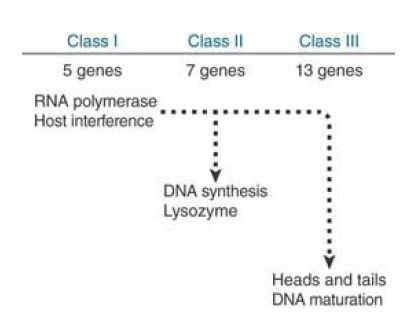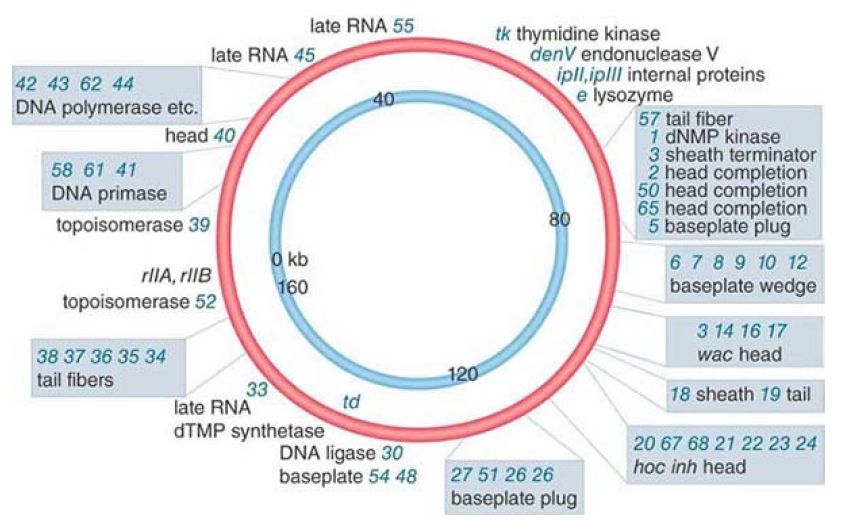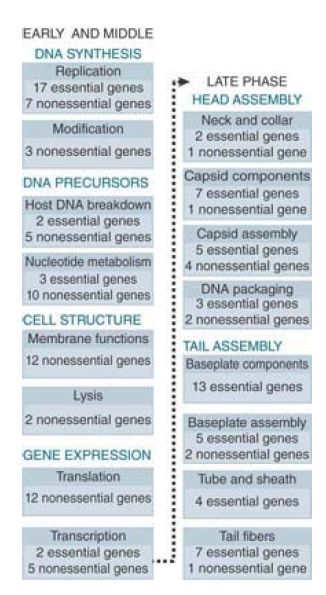


 النبات
النبات
 الحيوان
الحيوان
 الأحياء المجهرية
الأحياء المجهرية
 علم الأمراض
علم الأمراض
 التقانة الإحيائية
التقانة الإحيائية
 التقنية الحيوية المكروبية
التقنية الحيوية المكروبية
 التقنية الحياتية النانوية
التقنية الحياتية النانوية
 علم الأجنة
علم الأجنة
 الأحياء الجزيئي
الأحياء الجزيئي
 علم وظائف الأعضاء
علم وظائف الأعضاء
 الغدد
الغدد
 المضادات الحيوية
المضادات الحيوية|
Read More
Date: 6-12-2015
Date: 31-10-2020
Date: 25-4-2016
|
The Phage T7 and T4 Genomes Show Functional Clustering
KEY CONCEPTS
- Genes concerned with related functions are often clustered.
- Phages T7 and T4 are examples of regulatory cascades in which phage infection is divided into three periods.
The genome of phage T7 has three classes of genes, each of which constitutes a group of adjacent loci. As FIGURE 1 shows, the class I genes are the immediate early type and are expressed by host RNA polymerase as soon as the phage DNA enters the cell. Among the products of these genes are a phage RNA polymerase and enzymes that interfere with host gene expression.
The phage RNA polymerase is responsible for expressing the class II genes (which are concerned principally with DNA synthesis functions) and the class III genes (which are concerned with assembling the mature phage particle).

FIGURE 1. Phage T7 contains three classes of genes that are expressed sequentially. The genome is ~38 kb.
Phage T4 has one of the larger phage genomes (165 kb), which is organized with extensive functional grouping of genes. FIGURE 2 presents the genetic map. Essential genes are numbered: A mutation in any one of these loci prevents successful completion of the lytic cycle. Nonessential genes are indicated by three-letter abbreviations. (They are defined as nonessential under the usual conditions of infection. We do not really understand the inclusion of many nonessential genes, but presumably they confer a selective advantage in some of T4’s habitats. In smaller phage genomes, most or all of the genes are essential.)

FIGURE 2. The map of T4 is circular. T4 has extensive clustering of genes encoding components of the phage and processes such as DNA replication, but there is also dispersion of genes encoding a variety of enzymatic and other functions. Essential genes are indicated by numbers. Nonessential genes are identified by letters. Only some representative T4 genes are shown on the map.
Three phases of gene expression have been identified. A summary of the functions of the genes expressed at each stage is shown in FIGURE 3. The early genes are transcribed by host RNA polymerase. The middle genes are also transcribed by host RNA polymerase, but two phage-encoded products, MotA and AsiA, also are required. The middle promoters lack a consensus –35 sequence and instead have a binding sequence for MotA. The phage protein is an activator that compensates for the deficiency in the promoter by assisting host RNA polymerase to bind. The early and middle genes account for virtually all of the phage functions concerned with the synthesis of DNA, modifying cell structure, and transcribing and translating phage genes.
The two essential genes in the “transcription” category fulfill a regulatory function: Their products are necessary for late gene expression. Phage T4 infection depends on a mechanical link between replication and late gene expression. Only actively replicating DNA can be used as a template for late gene transcription. The connection is generated by introducing a new sigma factor and also by making other modifications in the host RNA polymerase so that it is active only with a template of replicating DNA. This link establishes a correlation between the
synthesis of phage protein components and the number of genomes available for packaging.

FIGURE 3. The phage T4 lytic cascade falls into two parts: Early functions are concerned with DNA synthesis; late functions with particle assembly.



|
|
|
|
علامات بسيطة في جسدك قد تنذر بمرض "قاتل"
|
|
|
|
|
|
|
أول صور ثلاثية الأبعاد للغدة الزعترية البشرية
|
|
|
|
|
|
|
مكتبة أمّ البنين النسويّة تصدر العدد 212 من مجلّة رياض الزهراء (عليها السلام)
|
|
|